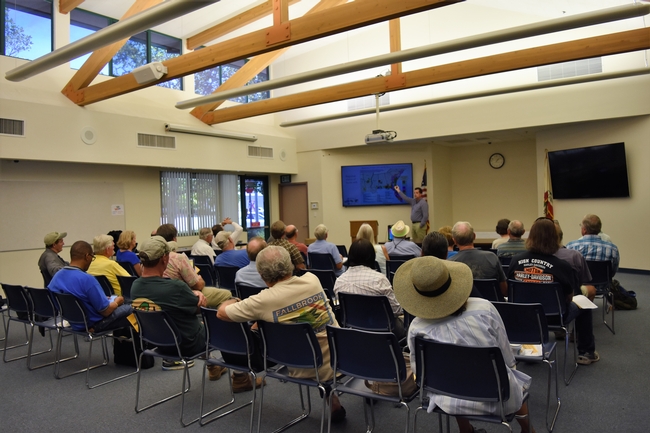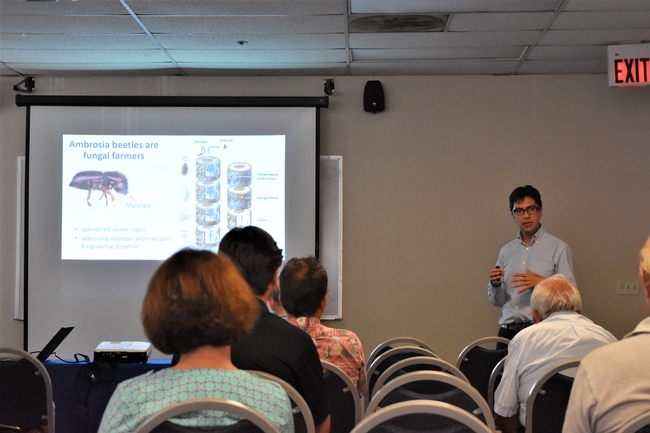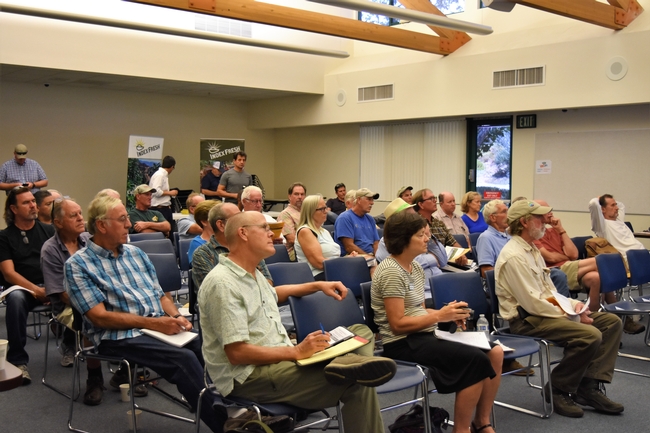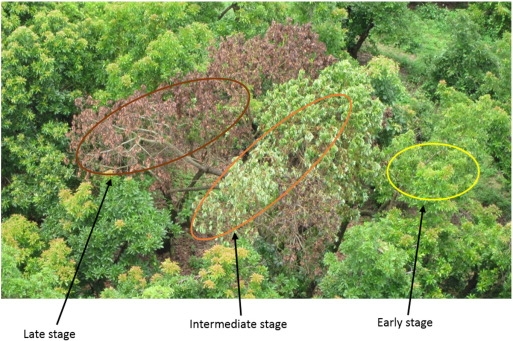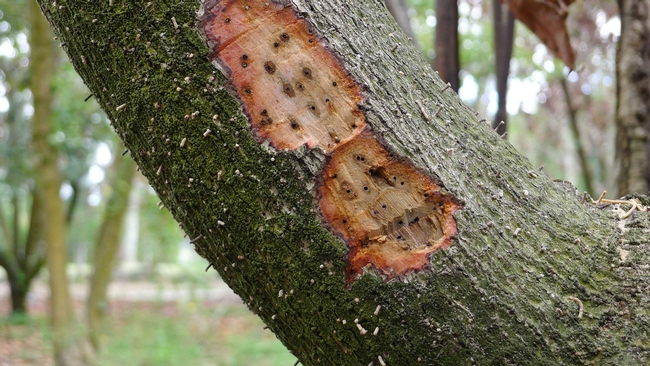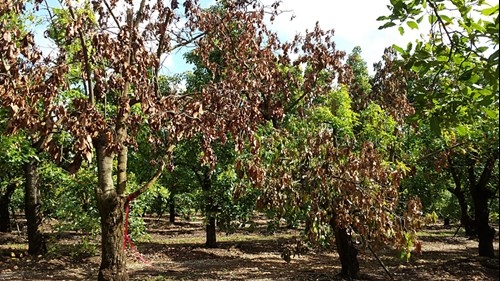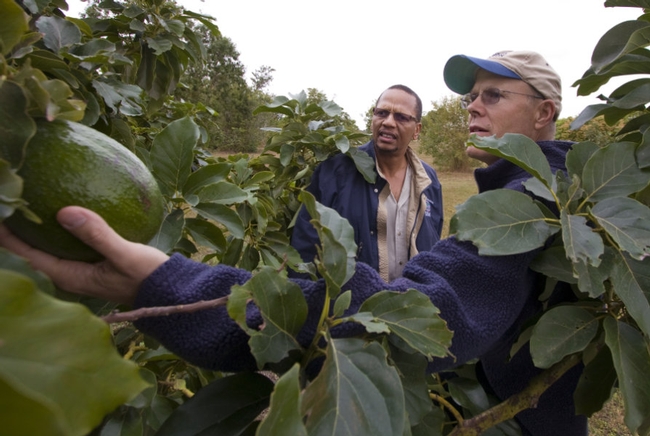
Posts Tagged: Florida
Florida Orange Production UP!!!
The USDA has summarized the US citrus crop for 2018-19 and it is up for both California and Florida, with CA accounting for 51% of US production! But the Florida orange crop is up from last year. This is the state that is getting hammered by huanglongbing amongst all the other demands being made on that industry. This is good news for citrus.
The full report is Here
But the summary is:
Citrus utilized production for the 2018-19 season totaled 7.94 million tons, up 31 percent from the 2017-18 season. California accounted for 51 percent of total United States citrus production; Florida totaled 44 percent, and Texas and Arizona produced the remaining 5 percent.
Florida's orange production, at 71.8 million boxes, is up 59 percent from the previous season.Grapefruit utilization in Florida, at 4.51 million boxes, is up 16 percent from last season's utilization. Florida's total citrus utilization increased 56 percent from the previous season. Bearing citrus acreage, at 387,100 acres, is 13,800 acres below the 2017-18 season.
Utilized citrus production in California increased 15 percent from the 2017-18 season. California's all orange production, at 49.8 million boxes, is 13 percent higher than the previous season. Grapefruit production is down 16 percent from the 2017-18 season but tangerine and mandarin production is up 35 percent. Utilized production of citrus in Texas is up 29 percent from the 2017-18 season. Orange production is up 33 percent from the previous season and grapefruit production increased 27 percent. Total citrus production in Arizona's lemon production is up 35 percent from last season.
The value of the 2018-19 United States citrus crop increased 1 percent from last season, to $3.35 billion (packing house-door equivalent). Orange value of production decreased 7 percent from last season and grapefruit value is down 1 percent.
Tangerine and mandarin value of production is 31 percent higher than last season but lemon value of production is down 4 percent.
Overall comparisons discussed above are based on similar fruit types. The revised production and utilization estimates are based on all data available at the end of the marketing season, including information from marketing orders, shipments, and processor records. Allowances are made for recorded local utilization and home use. Estimates for the 2018-19 California Valencia oranges and grapefruit are preliminary.
BUT, the latest news from the Central Valley navel forecast is that it is down,
The 2019-20 California navel crop is down 7% from last season, according to the first U.S. Department of Agriculture estimate.
With harvest expected to begin in October, the California navel forecast is 76 million (40-pound) cartons, down 7% percent from the previous year, the USDA said Sept. 12.
Farming is a roller coaster.

citrus cornucopia
Hass or Haas Avocado?
There was just a group of Florida researchers here in California sharing their experiences with ambrosia beetles and a fungal disease in avocado and other members of the laurel family. This is a pest/disease complex similar to that found here caused by a shot hole borer and fusarium. Avocados grown in Florida are of the West Indian or West Indian cross with Mexican or Guatemalan varieties. They are usually big, green fruit that tend to be of a lower oil content. Some marketers promote them as “low cal” or “slimcados” as a result. Whatever.
One of the things that struck home during these wonderful talks was the pronunciation of the word Hass. It was “hozzz”. The “a” was pronounced like the a in hot, not in hat. It made me think that this is probably how our familiar fruit is probably pronounced in much of the US. I also hear Californians (and CA growers, too) pronounce this iconic fruit “hozzz”. The generally accepted pronunciation of this name is “HaaaaSSSSS”. Like in the verb “has” - “He has an avocado”.
The fruit variety was found by a California grower named Rudolph Hass in the 1920's. The name Hass is of German origin. How it has come to be pronounced differently from his name is not clear to me. According to Google Translate, even in German it is pronounced as “has”, though with a somewhat clipped “s” on the end.
And not only has the pronunciation of the name been changed, sometimes the spelling in many produce departments is “Haas”. I once saw it on packaging spelled this way and when I asked the produce manager how that had happened, he told me that they had asked the packer explicitly to spell it that way because that's the way the consumers wanted to see it spelled.
So, the consumer drives the market. Maybe how people say it isn't important, as long as they know what they are buying and enjoy the fruit. At least most Californians seem to know how to say the word Hass.
Can you say Hass?
Photo: On the left: Florida (Slimcado) avocado. On the right: Haas avocado or Lamb-Haas. From: The Gardening Cook, http://thegardeningcook.com/slimcado-information/

Hass vs Haas
University of Florida Researchers Visit California for Laurel Wilt Summit Avocado Seminar Series
During the first week of August, the California Avocado Society, Inc., California Avocado Commission, University of California Cooperative Extension hosted six Laurel wilt researchers from the University of Florida. The speakers were Randy Ploetz, Jonathan Crane, Bruce Schaffer, Daniel Carrillo, Jeff Wasielewski and Edward Evans. In addition to talking at all three seminar locations, San Luis Obispo, Ventura, and Fallbrook, the researchers were also able to tour the major avocado growing regions.
Laurel wilt is a deadly disease of redbay (Persea borbonia) and other tree species in the Laurel family (Lauraceae), which includes the avocado tree. The disease is caused by a fungus (Raffaelea lauricola) that is introduced into host trees by a nonnative insect, the redbay ambrosia beetle (Xyleborus glabratus). Native to Southeast Asia, the ambrosia beetle has similarities to our current ambrosia pest, Polyphagous shot hole borer and the Kuroshio Borer. That is why this visit from our fellow extension researchers from the University of Florida. However the fungus associated with Laurel Wilt is unlike the disease here in California. Laurel Wilt is a disease that that causes a reaction in the tree to restrict water flow in the tree and the tree collapses rapidly. The tree dies so fast that it doesn't even have a chance for the leaves to fall of the dead branches.
The beetle has the ability to spread the specific pathogen to other ambrosia beetle vectors which happens when they feed on infected trees. Sanitation is the most effect way to manage this problem. Scouting for wilted branches and their rapid removal has been the key to early intervention and eradication. Dr. Ploetz suggests removing the tree immediately. By the time you see frass and streaks in the wood, the tree is already infected and has been for sometime. As soon as a growers see the wilt in the branches, its time to move quickly. This disease may be mistaken for Verticillium wilt or Phytophthora. It can spread throughout the grove by root grafting.
The generation time for the beetle inside avocado trees takes about 40-50 days depending upon temperatures. Their flight activity is highest in the late afternoon and early evening. Dr. Carrillo mentioned that ambrosia beetles are notoriously difficult to control because they are inside the tree most of their life cycle versus being outside the tree. Contact herbicides will not work, because the insects are primarily inside the tree. One of the first goals to avoid infection, is to keep your trees healthy. A sick tree is more attractive 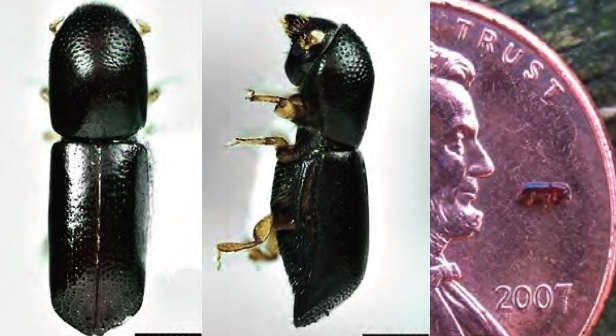
Scouting for laurel wilt in commercial avocado groves
1. Surveying for the symptoms of laurel wilt is a key component of limiting the spread of laurel wilt. Growers and their workers should survey their groves immediately and then weekly or more often if an infestation is detected in an adjacent grove. Pathogen sniffing dogs are currently being used, however there are less than half-dozen trained dogs for this purpose. Symptoms to look for might include:
i. Leaf and young stem wilting.
ii. Leaf color changing from light green to dark green, bluish-green or greenish-brown. Some leaves showing leaf mottling (dark and light green areas) and yellowing.
iii. Dead leaves curled hanging on the tree.
iv. A few stems and limbs with 2 to 4 ft of dieback or whole sections or entire limbs with dieback.
v. Inspection of the trunk and major limbs may show dried sap (white, crystalline powdery material) that indicates insect boring. In any case, on symptomatic limbs remove the bark down to the sapwood and look for dark streaking. Dark streaks in the sapwood may indicate fungal infection. Normally this sapwood should be white to yellowish with no dark staining or streaking. In addition, small, dark holes in the sapwood further indicate wood boring beetles are present.
2. If the tree shows only a few stems and limbs with 2 to 4 ft of dieback, wait for confirmation of laurel wilt before removing the tree. You can remove the dead part of the limb by cutting several feet below the dead area of the limb; burn or bury the infested limb.
Avocado Grower Seminar Series – Ambrosia Beetle Seminar Coming to California
“Laurel wilt – A new threat to California's avocado industry”
Presented by: California Avocado Society, Inc., California Avocado Commission, University of California Cooperative Extension, and University of Florida's Tropical Research and Education Center. Event is FREE, everyone is welcome!
- Tuesday, August 1, 2017, 1:00 p.m. to 3:00 p.m.,
UC Cooperative Extension Office Auditorium, 2156 Sierra Way, San Luis Obispo, CA 93401
- Wednesday, August 2, 2017, 9:00 a.m. to 11:00 a.m.,
UC Cooperative Extension Office Auditorium, 669 County Square Dr. Ventura, CA 93003
- Thursday, August 3, 2017, 1:00 p.m. to 3:00 p.m.,
Fallbrook Public Utility District Board Rm., 990 East Mission Rd. Fallbrook, CA 92028
Agenda
|
|
Speaker(s) |
Title |
|
|
Jeff Wasielewski, Subtropical Fruit Agent, University of Florida Extension |
The current status of laurel wilt in South Florida |
|
|
Randy Ploetz, Professor of Plant Pathology at the Tropical Research & Education Center of the Institute of Food & Agricultural Sciences (IFAS), University of Florida |
Laurel wilt epidemiology and management |
|
|
Bruce Schaffer, Professor of Ecophysiology of Subtropical and Tropical Horticultural Crops,IFAS, University of Florida
|
Vascular physiology and anatomy of different avocado genotypes relative to laurel wilt susceptibility |
|
|
Daniel Carrillo, Professor of Entomology and Nematology in Subtropical and Tropical Horticultural Crops, IFAS, University of Florida
|
Laurel wilt vectors: biology and management |
|
|
Edward Evans, professor in the Food and Resource Economics Department located at the University of Florida's Tropical Research and Education Center |
Economic impact and economics of control strategies |
|
|
Jonathan Crane, Professor of Horticulture / Tropical Fruit Crop Specialist, University of Florida's Tropical Research and Education Center |
Current control strategies, recommendations and issues |

Laurel Wilt Cycle
UF researchers find genetic cause for citrus canker, putting them a step closer to a cure
GAINESVILLE, Fla. — Researchers from the Institute of Food and Agricultural Sciences at the University of Florida are closer to finding a possible cure for citrus canker after identifying a gene that makes citrus trees susceptible to the bacterial pathogen.
Citrus canker, which causes pustules on fruit, leaves and twigs, is a highly contagious plant disease and spreads rapidly over short distances. Wind-driven rain, overhead irrigation, flooding and human movement can spread citrus canker. Human transport of infected plants or fruit spreads the canker pathogen over longer distances.
In Florida, the last extensive canker outbreak occurred beginning in 1995, which led to an ultimately unsuccessful eradication program that ended in 2006. That effort cost an estimated $1 billion and stimulated renewed efforts for more effective and economical controls. Farmers destroyed more than 16.5 million citrus trees between 1995 and 2012.
Yang Hu, a former doctoral student working with Jeff Jones, a professor in plant pathology, found the critical trait in the bacterium that is necessary for disease development. Hongge Jia, a researcher at UF's Citrus Research and Education Center in Lake Alfred, and Nian Wang, an associate professor in microbiology and cell science also based at the Citrus REC, along with six researchers from three universities worked on the project, as well.
Citrus canker continues to be a problem and exists in most citrus-growing areas in Florida. While scientists like Hu are devoted to eradicating the disease, many other researchers are now also battling citrus greening, which threatens to wipe out the $9 billion industry.
Citrus canker is caused by the bacteria Xanthomonas citri. While studying the bacterial pathogen's role in infected citrus, researchers were able to identify a gene in citrus critical to the development of citrus canker, known as the susceptibility, or “S” gene.
By finding the susceptibility gene, researchers say they are closer to a cure for the disease.
“The S gene represents an excellent candidate for control measures for the citrus bacterial canker,” Hu said.
Hu and Jones said they hope to secure funding to support further research, and have already identified several genes they believe could be engineered to obtain broad-spectrum plant resistance to most kinds of citrus canker.
“Once you know what the susceptibility gene is, it's possible to design multiple strategies for disease control,” Jones said.
The research paper was published online this month by Proceedings of the National Academy of Sciences: http://www.pnas.org/content/early/2014/01/08/1313271111.abstract.

citrus frost

